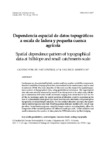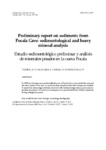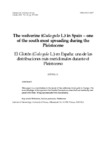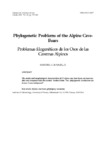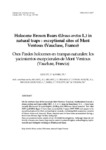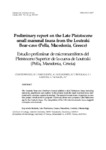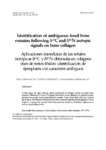Buscar
Mostrando ítems 21-30 de 37
Cave Bear ancestors
(Universidade da Coruña, 2001)
[Abstract] The lineage of the cave bear Ursus deningeri--> U. Spelaeus is well known, but to draw a limit in this evolution is not easy. The real difficulty is met when this cave bear lineage has to be linked to its ...
Dependencia espacial de datos topográficos a escala de ladera y pequeña cuenca agrícola
(Universidade da Coruña, 2001)
[Abstract] Landscapes are characterized by both, random and non-random variability components. Random variability of topographical data, summarized by the semivariance, may be used to elaborate DEMs. The main objective of ...
The Evolution of Metapodial Bones in the Cave Bear Group and its biostratigraphical Implications
(Universidade da Coruña, 2001)
[Abstract] A short description of the methods is followed by some central results obtained from the analyses of metapodial bones in the cave bear group from sites in Austria and Italy. The evolution of metapodials shows, ...
Preliminary report on sediments from Pocala Cave: sedimentological and heavy mineral analysis
(Universidade da Coruña, 2001)
[Abstract] In 1999 two borings were performedin the area of Pocala Cave, one outside the cave and the other inside in the cave. In particular four samples of the first boring were studied.It seems that mineralogy is strictly ...
The wolverine (Gulo gulo L.) in Spain – one of the south most spreading during the Pleistocene
(Universidade da Coruña, 2001)
[Abstract] This paper is a contribution to the study of the wolverine (Gulo gulo ) in Europe. The scarce findings of this species in the Iberian Peninsula are described and metrically compared with those living representants ...
Phylogenetic Problems of the Alpine Cave-Bears
(Universidade da Coruña, 2001)
[Abstract] The metric and morphological characteristics of 23 alpine cave bear fauna are been studied and compared with the normal lowland form. The phylogenetic conclusions are drawn: 3 new subspecies?
Holocene Brown Bears (Ursus arctos L.) in natural traps : exceptional sites of Mont Ventoux (Vaucluse, France)
(Universidade da Coruña, 2001)
[Abstract] On the northern face of the mountain Mont Ventoux (Vaucluse, Southeastern France), a dozen cavities and traps (called MV1, 2, 3, 4 ( = Aven du René-Jean), 5, 6 ...) have been recently discovered by speleologists, ...
Preliminary report on the Late Pleistocene small mammal fauna from the Loutraki Bear-cave (Pella, Macedonia, Greece)
(Universidade da Coruña, 2001)
[Abstract] The Loutraki Bear-cave (Northern Greece) yielded a rich Pleistocene fauna including mammals, amphibians and reptiles. In the present study the small mammal fauna associated with cave-bear remains is studied. The ...
Reflections on the fate of some geomorphological ideas
(Universidade da Coruña, 2001)
[Abstract] In geomorphology, as in other sciences, investigation is concerned with the collection and characterisation of data, and the generation and testing of working hypotheses. Considering the analysis of landforms ...
Identification of ambiguous fossil bone remains following 13C and 15N isotopic signals on bone collagen
(Universidade da Coruña, 2001)
[Abstract] In this paper we deal with an useful application of isotopic studies on fossil bone remains. Following δ1 3C and δ1 5N signals recorded in bone collagen, it is possible to classify into the proper taxon some ...



